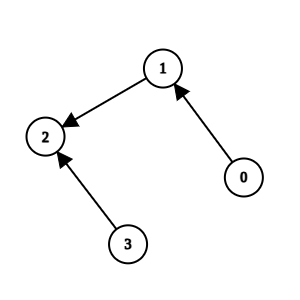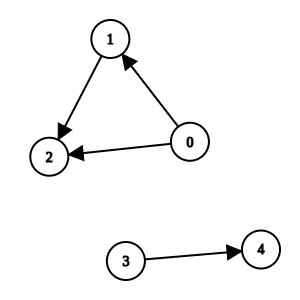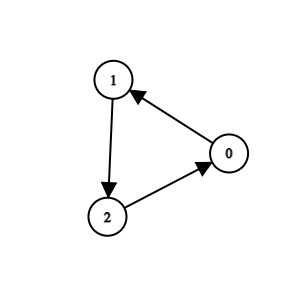题目描述
你正在维护一个项目,该项目有 n 个方法,编号从 0 到 n - 1。
给你两个整数 n 和 k,以及一个二维整数数组 invocations,其中 invocations[i] = [a_i, b_i] 表示方法 a_i 调用了方法 b_i。
已知如果方法 k 存在一个已知的 bug。那么方法 k 以及它直接或间接调用的任何方法都被视为 可疑方法,我们需要从项目中移除这些方法。
只有当一组方法没有被这组之外的任何方法调用时,这组方法才能被移除。
返回一个数组,包含移除所有 可疑方法 后剩下的所有方法。你可以以任意顺序返回答案。如果无法移除 所有 可疑方法,则 不 移除任何方法。
样例

输入:n = 4, k = 1, invocations = [[1,2],[0,1],[3,2]]
输出:[0,1,2,3]
解释:
方法 2 和方法 1 是可疑方法,但它们分别直接被方法 3 和方法 0 调用。
由于方法 3 和方法 0 不是可疑方法,我们无法移除任何方法,故返回所有方法。

输入:n = 5, k = 0, invocations = [[1,2],[0,2],[0,1],[3,4]]
输出:[3,4]
解释:
方法 0、方法 1 和方法 2 是可疑方法,且没有被任何其他方法直接调用。我们可以移除它们。

输入:n = 3, k = 2, invocations = [[1,2],[0,1],[2,0]]
输出:[]
解释:
所有方法都是可疑方法。我们可以移除它们。
限制
1 <= n <= 10^50 <= k <= n - 10 <= invocations.length <= 2 * 10^5invocations[i] == [a_i, b_i]0 <= a_i, b_i <= n - 1a_i != b_iinvocations[i] != invocations[j]
算法
(宽度优先遍历) $O(n + m)$
- 通过宽度优先遍历标记所有可疑的方法。
- 遍历所有的边,如果存在一条边的起点是不可疑的方法,但终点是可疑的方法,则无法删除。
- 否则,删除所有被标记的节点。
时间复杂度
- 宽度优先遍历的时间复杂度为 $O(n + m)$。
空间复杂度
- 需要 $O(n + m)$ 的额外空间存储邻接表,宽度优先遍历的队列和答案。
C++ 代码
class Solution {
public:
vector<int> remainingMethods(int n, int k, vector<vector<int>>& invocations) {
vector<vector<int>> graph(n);
for (const auto &e : invocations)
graph[e[0]].push_back(e[1]);
vector<bool> seen(n, false);
seen[k] = true;
queue<int> q;
q.push(k);
while (!q.empty()) {
int u = q.front();
q.pop();
for (int v : graph[u]) {
if (seen[v])
continue;
seen[v] = true;
q.push(v);
}
}
for (const auto &e : invocations)
if (!seen[e[0]] && seen[e[1]]) {
vector<int> ans(n);
iota(ans.begin(), ans.end(), 0);
return ans;
}
vector<int> ans;
for (int i = 0; i < n; i++)
if (!seen[i])
ans.push_back(i);
return ans;
}
};

